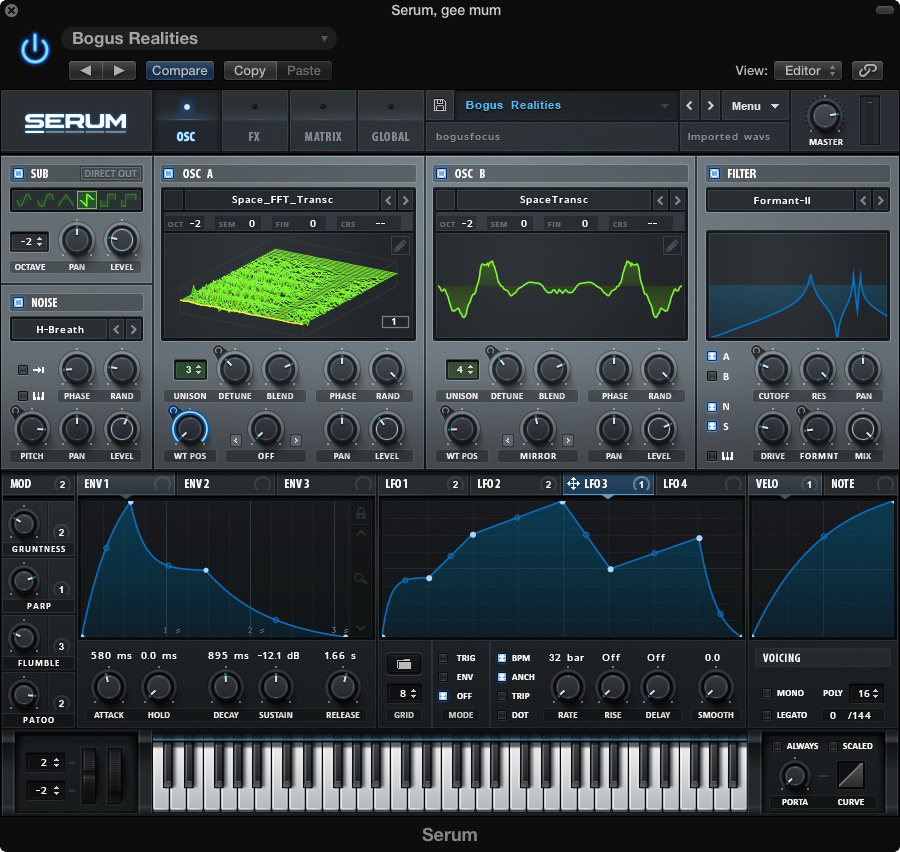Serum is a very notorious VST. It is a 2 oscillator wavetable synthesiser with endless filters, effects, and other features to create a vast variety of sounds. It is the first ever synth I got to learn properly and I use it in every single one of my songs (except the most recent 2 because I dont have any synths on my new laptop)
I am going to discuss the front page of serum as this is where all of the magic happens, there are other pages like the effects, matrix, and global but the main bulk of serum lies on this oscillator page.

Oscillators
The first feature of serum I would like to talk about are the oscillators. In Serum you have 2 main oscillators which are wavetable oscillators. A wavetable is a method of generating sound based on a single sampled waveform expressed as a table of values. Additionally you have a sub oscillator and a noise generator which you can use to further detail and sculpt your sound.
On the oscillators, you have a variety of parameters to play with. The volume level and pan are universal across all of them as well as the ability to change the pitch of it. The main 2 oscillators have 4 different parameters controlling the pitch of the waveform which allows for vast creativity when it comes to pitch bends. The main oscillators also have the unison function which plays several of the same wave but detuned at various points, as well as the ability to control the phase which is also available on the noise generator.
The best parameter by far though is the modulation, as you can see on the image of serum I have attached there is a dial which says off when there isn’t anything selected. However you have plenty of wave modulation processes to choose from like, FM, AM, Bend, Mirror, RM, and many more. This allows you to create some very very interesting sounds with these processes.
Filters
The filter section of serum is large. You have so many different filters you can choose from across the 4 pages of effects.
The first page has the more traditional filters, on here you will find Low Pass an High Pass of various degrees of intensity as well as Band Pass filters and Notch filters. These types of filters are the most basic and you can basically make them all on an EQ. My personal favourite on this list is the Low Pass 18 which is great for filter sweeps when you are making aggressive dubstep basses.
The second page has combined filters. Here you will find filters which are 2 or even more in 1. For instance you may have a filter which is both a Low Pass and a Notch or my personal favourite off this list being the Peak Notch filter. The filters on this page are great for creating more vocally synth sounds as well as warping from 1 style of filter to another.
The third page and the fourth page contain much more exotic and outlandish effects. Here you will be able to find flanges, phasers, combs, and even a reverb filter. With this page there is so much creativity you can unleash and you can really make some disgusting basses using the phasers on high resonance.
Envelopes
Finally, on serum you have 2 kinds of envelope. You have the ADSR envelope which actually has an extra parameter called Hold, and the LFO section. The ADSR envelope works like any other does except you can change the curvature of the envelope and it is visualized very very well.
The LFO section has more variance, with the ability to set the looping mode to 3 different settings, as well as other settings such as anchoring, triplet grid, and the possibility to either use the beat grid of the song or just go off of hz.
References
Hahn, M. (2024) Xfer serum: The Ultimate Serum Guide for Producers, LANDR Blog. Available at: https://blog.landr.com/xfer-serum/ (Accessed: 17 May 2024).